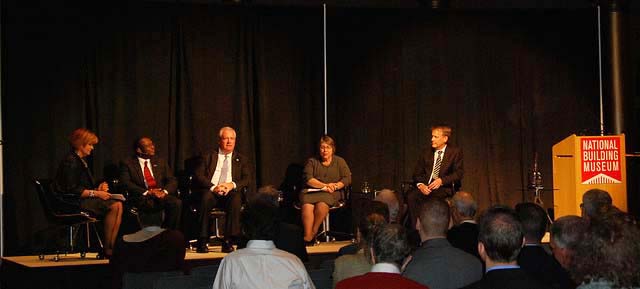The Turner Prize: What Does Academic Collaboration Mean?
“Coming together is a beginning; keeping together is progress; working together is success.” – Henry Ford
That powerful quote was used by Karen Sweeney (’80 AE) to close out the 2014 Henry C. Turner Prize for Innovation in Construction event on Wednesday, December 3, 2014 at the National Building Museum in Washington, D.C.
Sweeney, Senior Vice President: Diversity, Inclusion and Community at Turner Construction, served as moderator of the panel discussion after the Penn State Department of Architectural Engineering was recognized for bringing together students, educators, researchers, government entities, and industry to build efficiencies in the building industry and encourage energy-efficient building solutions.
The award committee specifically cited architectural engineering’s GridSTAR Center efforts at the Navy Yard in Philadelphia as one of the reasons for honoring Penn State with this year’s prize.
“We were missing a real practical practice in engineering so the Philadelphia Industrial Development Corporation went to Penn State to collaborate on the Navy Yard development,” explained John Grady, Turner Prize panelist and president, Philadelphia Industrial Development Corporation. “Penn State warmed to the challenge quickly, especially the College of Engineering and especially the Department of Architectural Engineering. They knew how to be a difference maker. They were entrepreneurial and recognized that coming into Philadelphia meant bringing something new to the relationship.”
Panelist Ted Lynch (’92 AE, ’96 PhD), president, Southland Industries, agreed that Penn State is willing to adapt to the needs of its partners. “Penn State architectural engineering is responsive to the needs of the design/build industry,” he said.
One area of opportunity, Lynch said, is for industry and higher education to collaborate in the research areas that would help address the many issues and challenges facing the industry.
“The traditional university system isn’t set up to encourage collaboration, or at least not without too much bureaucracy,” Grady said.
“We have the freedom to establish programs like GridSTAR and engage students who are interested in these programs,” said Chimay Anumba, department head, Penn State Department of Architectural Engineering.
Another panelist and former under-secretary at the United States Department of Education, Martha Kanter, said that other universities should look at Penn State architectural engineering’s track record of preparing students for success and scale it to help solve the nationwide issue of students being underprepared for the work force.
“The nation needs graduates with imagination; students with cross- and multi-disciplinary approaches to problem solving,” Grady said. “Universities have the opportunity to bring all this together in order to train future leaders.”

The presentation of the Turner Prize (l. to r.): Chase Rynd, executive director, National Building Museum; Chimay Anumba, department head, Penn State Department of Architectural Engineering; David Riley, professor of architectural engineering and director of the GridSTAR Center; Anthony Atchley, senior associate dean, Penn State College of Engineering; Peter J. Davoren, president and chief executive officer, Turner Construction.

Karen Sweeney, left, moderates a conversation on innovation, education, and collaboration as driving forces in economic development and a 21st-century workforce. Panelists (L-R): Chimay Anumba, John Grady, Martha Kanter, and Ted Lynch.
Read More


Follow Us!